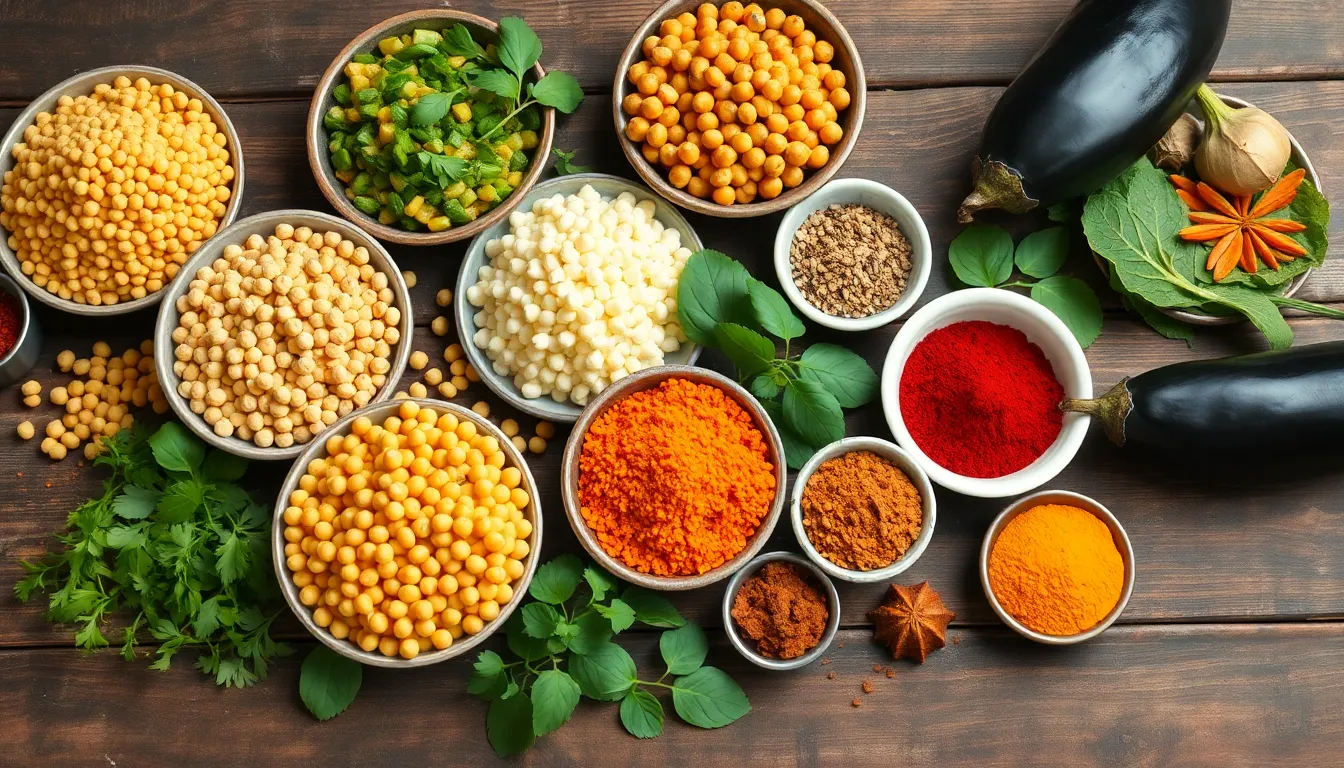Physical Address
304 North Cardinal St.
Dorchester Center, MA 02124

Indian vegan recipes are like a vibrant festival for the taste buds. Bursting with spices and flavors, they prove that plant-based meals can be anything but boring. Imagine savoring a creamy coconut curry that dances on your palate or indulging in crispy samosas that make your heart sing. Who said vegan food has to be bland?
Indian vegan recipes feature an array of flavorful plant-based dishes. They highlight diverse ingredients such as lentils, vegetables, grains, and spices. Traditional Indian cuisine embraces a rich tapestry of flavors, breaking the myth that plant-based meals lack excitement.
Prominent examples include dal, a hearty lentil dish, and chana masala, a spiced chickpea curry. These meals offer robust tastes and satisfy hunger effectively. Cooking techniques such as sautéing, steaming, and roasting enhance the nutritious qualities of ingredients while preserving intrinsic flavors.
Seasonal vegetables hold a central role in Indian vegan recipes. Popular vegetables like spinach, eggplant, and cauliflower add color and texture to meals. Each region in India contributes unique recipes, showcasing local produce and traditional techniques. For instance, South Indian cuisine often incorporates coconut and curry leaves, while North Indian recipes frequently utilize dairy alternatives like coconut milk or almond milk.
Spices are essential, enriching the flavor profile of any dish. Common spices include cumin, turmeric, and coriander, all of which enhance the health benefits of meals. These ingredients not only serve to elevate taste but also promote overall wellness.
Indian vegan recipes are unquestionably diverse, combining flair, nutrition, and tradition. Each dish invites culinary exploration, demonstrating that plant-based eating can be both vibrant and satisfying.

Indian vegan cuisine incorporates a variety of ingredients that lend unique flavors and textures to dishes. Knowledge of these components enhances the cooking experience and elevates overall meals.
Legumes and pulses form the foundation of many Indian vegan recipes. Lentils, chickpeas, and black beans provide essential protein and fiber. Varieties like red lentils and split peas cook quickly and contribute vibrant colors. Chickpeas serve as a versatile base for dishes such as chana masala and hummus. Cooking techniques often involve boiling, pressure cooking, or slow simmering to achieve desired flavors and textures, making these ingredients not only nutritious but also satisfying.
Seasonal vegetables and greens offer the essential freshness in Indian vegan cooking. Spinach, eggplant, and cauliflower stand out as popular choices, each bringing unique flavors. Stir-frying or steaming helps retain nutrients while blending well with spices. Regional specialties highlight local produce, showcasing variety across different Indian states. Moreover, vegetables can serve as the main component in dishes like bhindi masala or aloo gobi, providing both nutrition and appeal.
Spices and herbs are integral to enriching Indian vegan dishes. Cumin, turmeric, and coriander contribute distinct aromas and flavors. Each spice serves a purpose, enhancing not only taste but also health benefits. Fresh herbs like cilantro and mint add a burst of freshness to curries and salads. Utilizing spices creates a vibrant flavor profile, transforming simple ingredients into culinary masterpieces. Understanding the balance of spices is crucial for achieving an authentic taste in vegan dishes.
Indian vegan recipes showcase a delightful array of flavors, making plant-based meals exciting and satisfying. Each dish reflects rich cultural traditions and vibrant ingredients.
Samosas serve as a favorite starter, filled with spiced potatoes and peas, often paired with tangy tamarind chutney. Vegetable pakoras provide crispy satisfaction, featuring a mix of vegetables dipped in chickpea flour and fried until golden. A refreshing option often enjoyed is cucumber raita, made with dairy-free yogurt, diced cucumbers, and spices, perfect for cooling the palate. Puffed rice and sev combine to form bhel puri, a street food staple bursting with textures and flavors.
Chana masala stands out as a hearty dish featuring chickpeas simmered in a spiced tomato sauce. Tofu tikka masala showcases marinated tofu cooked in a creamy, spiced sauce, offering a rich alternative to traditional meat preparations. A staple in many households, dal provides a comforting experience with lentils cooked and spiced to perfection. Additionally, mixed vegetable curry brings together seasonal vegetables simmered in a fragrant gravy, embodying the essence of home-cooked Indian meals.
Gulab jamun, made from milk powder, creates soft, syrup-soaked balls that are simply irresistible. Coconut laddu offers a quick and sweet treat, made with grated coconut, sweeteners, and formed into bite-sized balls. Kheer, a rice pudding, adapts beautifully with almond milk, providing a creamy texture and sweetness. Lastly, fruit chaat combines fresh seasonal fruits with tangy spices, creating a refreshing end to any meal.
Cooking Indian vegan dishes involves thoughtful meal preparation and careful flavor enhancement. By taking the right steps, anyone can create delightful and nutritious meals.
Start by gathering all ingredients before cooking. This practice ensures a smoother cooking experience. Chopping vegetables in advance saves time later. Keep common ingredients on hand, such as lentils, chickpeas, and spices, for easy access. Use fresh seasonal vegetables for the best flavors and nutrients. Properly soaking beans also reduces cooking time and improves digestion. Try organizing meals weekly, allowing for creativity and convenience.
Utilize a variety of spices to achieve depth in dishes. Begin with sautéing onions and garlic to form a flavorful base. Incorporate spices like cumin, coriander, and turmeric early in the process for maximum aroma. Add fresh herbs at the end of cooking for a burst of freshness. Experimenting with different spice blends can elevate simple dishes to extraordinary meals. Consider using acid, such as lemon juice or tamarind, to balance flavors. Allow dishes to simmer so that spices fully infuse and meld.
Indian vegan recipes offer a vibrant journey through flavors and textures that can transform any meal. With an emphasis on fresh ingredients and aromatic spices these dishes not only satisfy hunger but also nourish the body. The variety of options from appetizers to desserts showcases the versatility of plant-based cooking.
By embracing techniques that enhance flavors and utilizing seasonal produce anyone can create delightful meals that celebrate both tradition and innovation. Exploring Indian vegan cuisine reveals that plant-based eating is far from dull; it’s an exciting culinary adventure waiting to be savored.